A Multi-Frame GLMB Smoothing Based on the Image-Observation Sensor for Tracking Multiple Weak Targets Using Belief Propagation
Abstract
1. Introduction
2. Background
2.1. Multi-Frame GLMB Model
2.2. The Pixel-Image TBD Measurement Model
2.3. Multi-Frame GLMBs Approximation Recursion Based on KLD
3. An Efficient Implementation of MF-GLMB-TBD Smoother Based on Belief Propagation
3.1. The Posterior Density Formulation of Multi-Frame GLMB Model
3.2. The Review of the Belief Propagation
3.3. Message Passing Algorithm Based on Belief Propagation
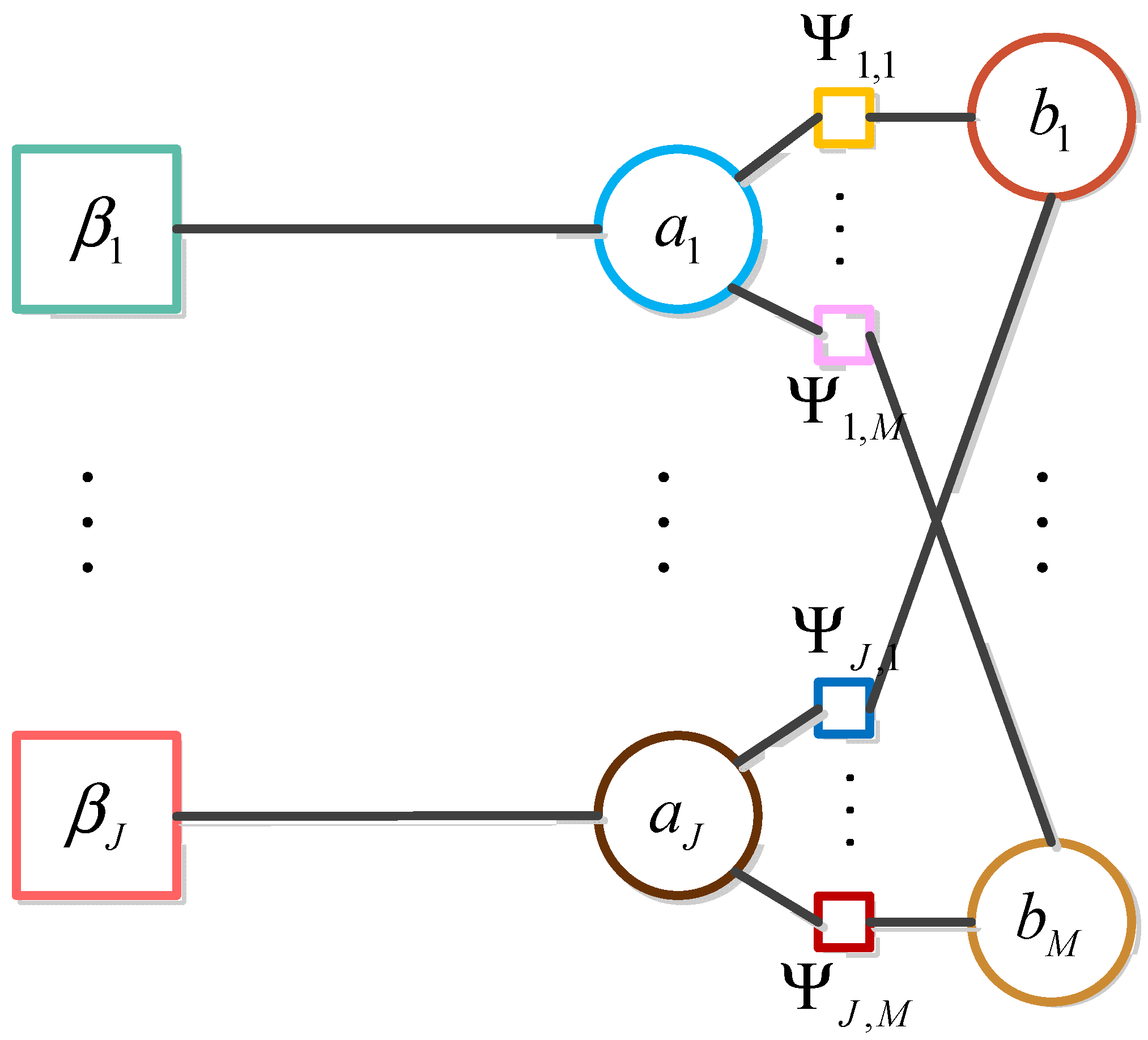
3.4. Marginal Association Probability Approximation Based on Belief Propagation
| Algorithm 1: BP-based GLMB approximation posterior density | ||
| Output: | ||
| For do | ||
| Calculate for as with given in (23) and for as , respectively The spatial densities for are respectively calculated according to (20) | ||
| End for | ||
| do | ||
| The message according to (60) | ||
| according to (61) | ||
| End for | ||
| The marginal are approximately calculated according to (62) and (64), respectively The update are calculated, respectively Calculate the MF-GLMB posterior density according to (38) and (39) Extract the multi-target state from the posterior density by maximum a posterior method | ||
3.5. Complexity Analysis
4. The Convergence Discussion on Data Association Based on Belief Propagation
5. Numerical Simulation
5.1. Simulation Setup
5.2. Simulation Results
5.2.1. Comparison with Smoother and Filter
5.2.2. Comparison with BP-Version and Gibbs Sampler-Version
6. Discussion
7. Conclusions
Author Contributions
Funding
Conflicts of Interest
References
- Vo, B.T.; Vo, B.N. Labeled random finite sets and multi-object conjugate priors. IEEE Trans. Signal Process. 2013, 61, 3460–3475. [Google Scholar] [CrossRef]
- Vo, B.N.; Vo, B.T.; Phung, D. Labeled random finite sets and Bayes multi-target tracking filter. IEEE Trans. Signal Process. 2014, 62, 6554–6567. [Google Scholar] [CrossRef]
- Vo, B.N.; Vo, B.T.; Hoang, H.G. An efficient implementation of the generalized labeled multi-Bernoulli filter. IEEE Trans. Signal Process. 2017, 65, 1975–1987. [Google Scholar] [CrossRef]
- Reuter, S.; Vo, B.T.; Vo, B.N.; Dietmayer, K. The labeled multi-Bernoulli filter. IEEE Trans. Signal Process. 2014, 62, 3246–3260. [Google Scholar]
- Beard, M.; Vo, B.T.; Vo, B.N. A Solution for large-scale multi-object tracking. IEEE Trans. Signal Process. 2020, 68, 2754–2769. [Google Scholar] [CrossRef]
- Beard, M.; Vo, B.T.; Vo, B.N. Bayesian multi-target tracking with merged measurements using labeled random finite sets. IEEE Trans. Signal Process. 2015, 63, 1433–1447. [Google Scholar] [CrossRef]
- Vo, B.N.; Vo, B.T. A multi-scan labeled random finite set model for multi-object state estimation. IEEE Trans. Signal Process. 2019, 67, 4948–4963. [Google Scholar] [CrossRef]
- Blackman, S.S. Multiple hypothesis tracking for multiple target tracking. IEEE Trans. Aerosp. Electron. Syst. 2004, 19, 5–18. [Google Scholar] [CrossRef]
- Vo, B.N.; Vo, B.T.; Cantoni, A. Analytic implementations of the Cardinalized probability hypothesis density filter. IEEE Trans. Signal Process. 2007, 55, 3553–3567. [Google Scholar] [CrossRef]
- Li, C.; Wang, W.; Kirubarajan, T.; Sun, J.; Lei, P. PHD and CPHD filtering with unknown detection probability. IEEE Trans. Signal Process. 2018, 66, 3784–3798. [Google Scholar] [CrossRef]
- Jones, B.A. CPHD filter birth modeling using the probabilistic admissible region. IEEE Trans. Aerosp. Electron. Syst. 2018, 54, 1456–1469. [Google Scholar] [CrossRef]
- Mahler, R.P.S.; Vo, B.T.; Vo, B.N. CPHD filtering with unknown clutter rate and detection profile. IEEE Trans. Signal Process. 2011, 59, 3497–3513. [Google Scholar] [CrossRef]
- Bryant, D.S.; Delande, E.D.; Gehly, S.; Houssineau, J.; Clark, D.E.; Jones, B.A. The CPHD filter with target spawning. IEEE Trans. Signal Process. 2017, 65, 1324–1338. [Google Scholar] [CrossRef]
- Wang, B.; Yi, W.; Hoseinnezhad, R.; Li, S.; Kong, L.; Yang, X. Distributed fusion with multi-Bernoulli filter based on generalized covariance intersection. IEEE Trans. Signal Process. 2017, 65, 242–255. [Google Scholar] [CrossRef]
- Vo, B.T.; Clark, D.; Vo, B.N.; Ristic, B. Bernoulli forward-backward smoothing for joint target detection and tracking. IEEE Trans. Signal Process. 2011, 59, 4473–4477. [Google Scholar] [CrossRef]
- Vo, B.N.; Vo, B.T.; Mahler, R.P.S. Closed-form solutions to forward-backward smoothing. IEEE Trans. Signal Process. 2012, 60, 2–17. [Google Scholar] [CrossRef]
- Yi, W.; Fang, Z.; Li, W.; Hoseinnezhad, R.; Kong, L. Multi-frame track-before-detect algorithm for maneuvering target tracking. IEEE Trans. Veh. Technol. 2020, 69, 4104–4118. [Google Scholar] [CrossRef]
- Vo, B.N.; Vo, B.T.; Pham, N.T.; Suter, D. Joint detection and estimation of multiple objects from image observation. IEEE Trans. Signal Process. 2010, 58, 5129–5141. [Google Scholar] [CrossRef]
- Li, S.; Yi, W.; Hoseinnezhad, R.; Wang, B.; Kong, L. Multi-object tracking for generic observation using labeled random finite sets. IEEE Trans. Signal Process. 2018, 66, 368–383. [Google Scholar] [CrossRef]
- Cao, C.; Zhao, Y. An efficient implementation of multiple weak targets tracking filter with labeled random finite sets for marine radar. Digit. Signal Process. 2020, 101, 102710. [Google Scholar] [CrossRef]
- Chai, L.; Kong, L.; Li, S.; Yi, W. The multiple model multi-Bernoulli filter based track-before-detect using a likelihood based adaptive birth distribution. Signal Process. 2020, 171, 107501. [Google Scholar] [CrossRef]
- Cao, C.; Zhao, Y. An efficient implementation of the multiple-model generalized labeled multi-Bernoulli filter for track-before-detect of point targets using an image sensor. IEEE Trans. Aerosp. Electron. Syst. 2021, 57, 4416–4432. [Google Scholar] [CrossRef]
- Papi, F.; Vo, B.N.; Vo, B.T.; Fantacci, C.; Beard, M. Generalized labeled multi-Bernoulli approximation of multi-object densities. IEEE Trans. Signal Process. 2015, 63, 5487–5497. [Google Scholar] [CrossRef]
- Bryant, D.S.; Vo, B.N.; Vo, B.T.; Jones, B.A. A generalized labeled multi-Bernoulli filter with object spawning. IEEE Trans. Signal Process. 2018, 66, 6177–6189. [Google Scholar] [CrossRef]
- Li, B.; Wu, Y.-C. Convergence analysis of Gaussian belief propagation under high-order factorization and asynchronous scheduling. IEEE Trans. Signal Process 2019, 67, 2884–2897. [Google Scholar] [CrossRef]
- Leng, M.; Wu, Y.C. Distributed clock synchronization for wireless sensor networks using belief propagation. IEEE Trans. Signal Process. 2011, 59, 5404–5414. [Google Scholar] [CrossRef]
- Awais, M.; Masera, G.; Martina, M.; Montorsi, G. VLSI implementation of a non-binary decoder based on the analog digital belief propagation. IEEE Trans. Signal Process. 2014, 62, 3965–3975. [Google Scholar] [CrossRef][Green Version]
- Soldi, G.; Meyer, F.; Braca, P.; Hlawatsch, F. Self-tuning algorithms for multisensory-multitarget tracking using belief propagation. IEEE Trans. Signal Process. 2019, 67, 3922–3937. [Google Scholar] [CrossRef]
- Mooij, J.M.; Kappen, H.J. Sufficient conditions for convergence of the sum-product algorithm. IEEE Trans. Inf. Theory 2007, 53, 4422–4437. [Google Scholar] [CrossRef]
- Wien, T.; Meyer, F.; Hlawatsch, F. A fast labeled multi-Bernoulli filter using belief propagation. IEEE Trans. Aerosp. Electron. Syst. 2020, 56, 2478–2488. [Google Scholar]
- Cao, C.; Zhao, Y. A multiple-model generalized labeled multi-Bernoulli filter based on blocked Gibbs sampling for tracking maneuvering targets. Signal Process. 2021, 186, 108119. [Google Scholar] [CrossRef]
- Vo, B.N.; Vo, B.T.; Beard, M. Multi-sensor multi-object tracking with the generalized labeled multi-Bernoulli filter. IEEE Trans. Signal Process. 2019, 67, 5952–5967. [Google Scholar] [CrossRef]
- Yi, W.; Chai, L. Heterogeneous multi-sensor fusion with random finite set multi-object densities. IEEE Trans. Signal Process. 2021, 69, 3399–3414. [Google Scholar] [CrossRef]
- Garcia-Fernandez, A.F.; Yi, W. Continuous-discrete multiple target tracking with out-of-sequence measurements. IEEE Trans. Signal Process. 2021, 69, 4699–4709. [Google Scholar] [CrossRef]
- Li, S.; Battistelli, G.; Chisci, L.; Member, S.; Yi, W.; Wang, B.; Kong, L. Computationally Efficient Multi-agent multi-object tracking with labeled random finite sets. IEEE Trans. Signal Process. 2019, 67, 260–275. [Google Scholar] [CrossRef]
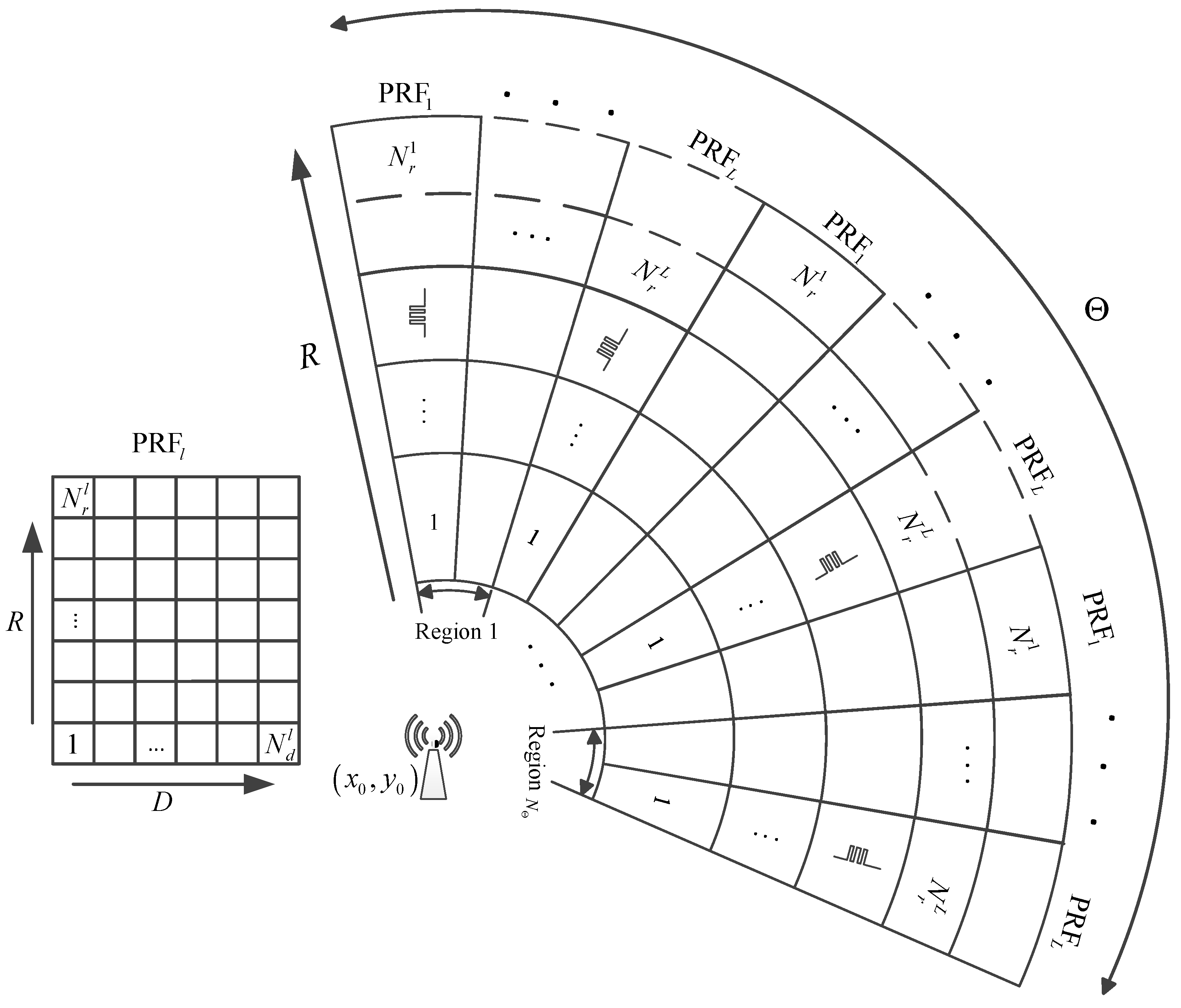
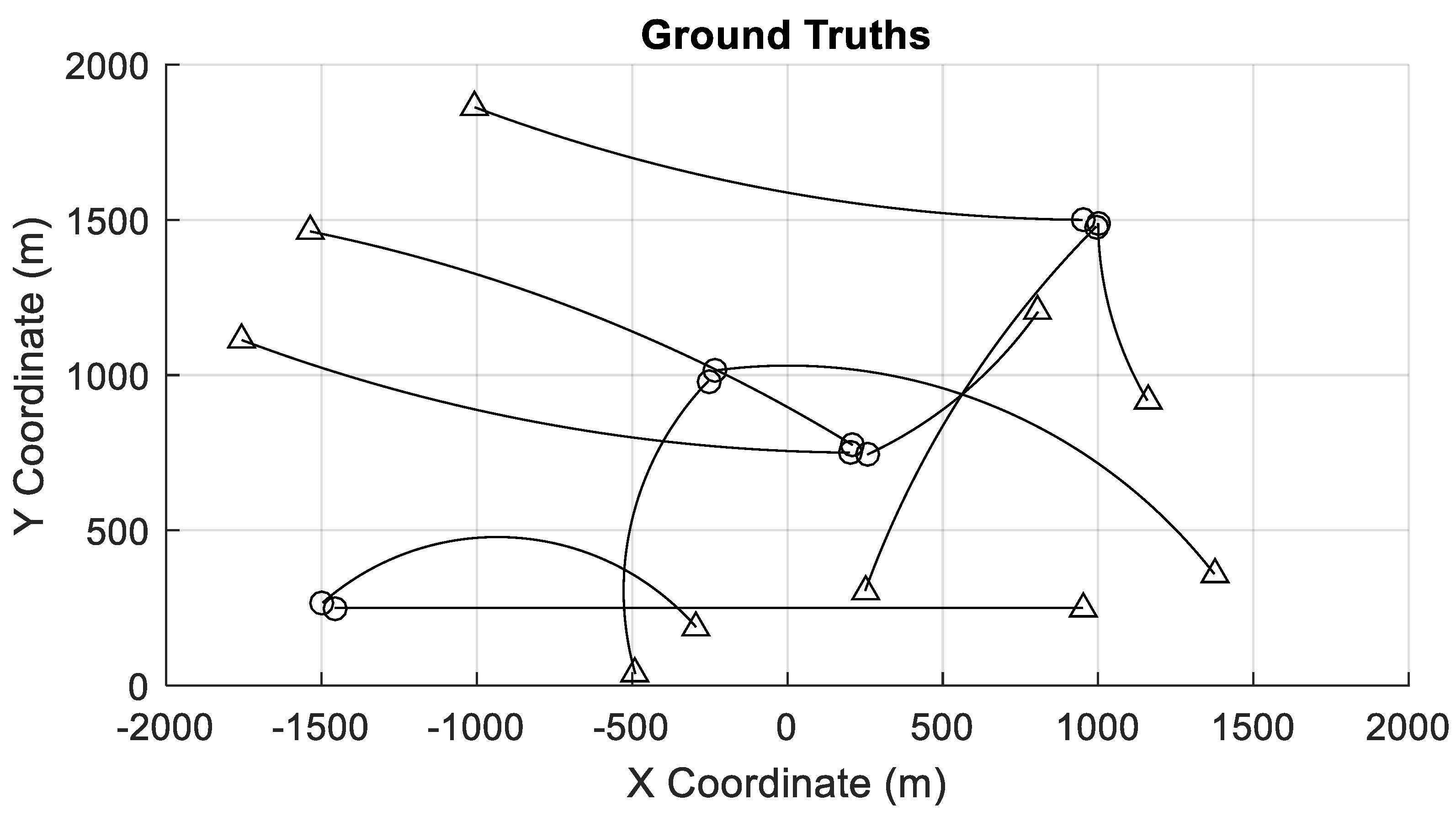
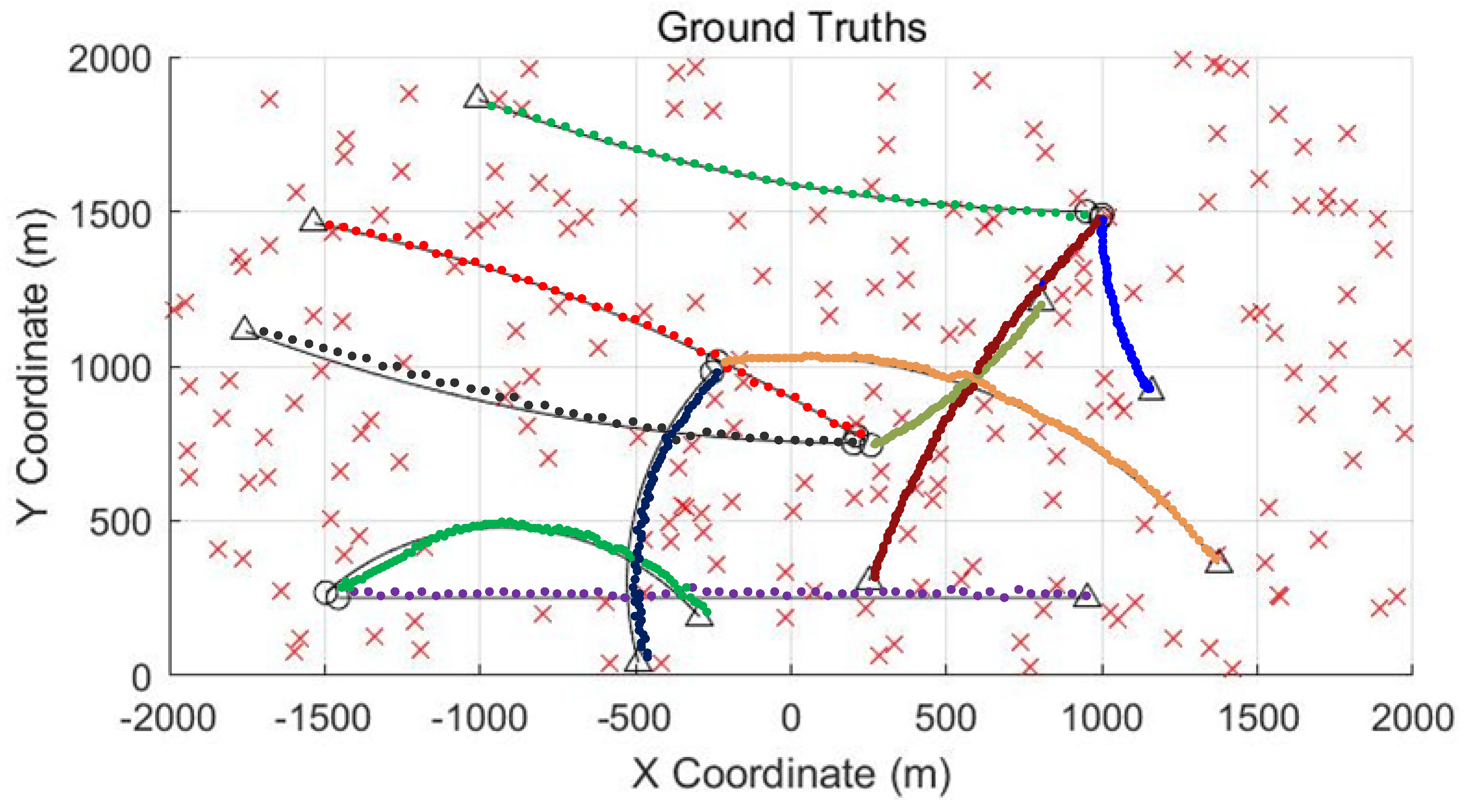
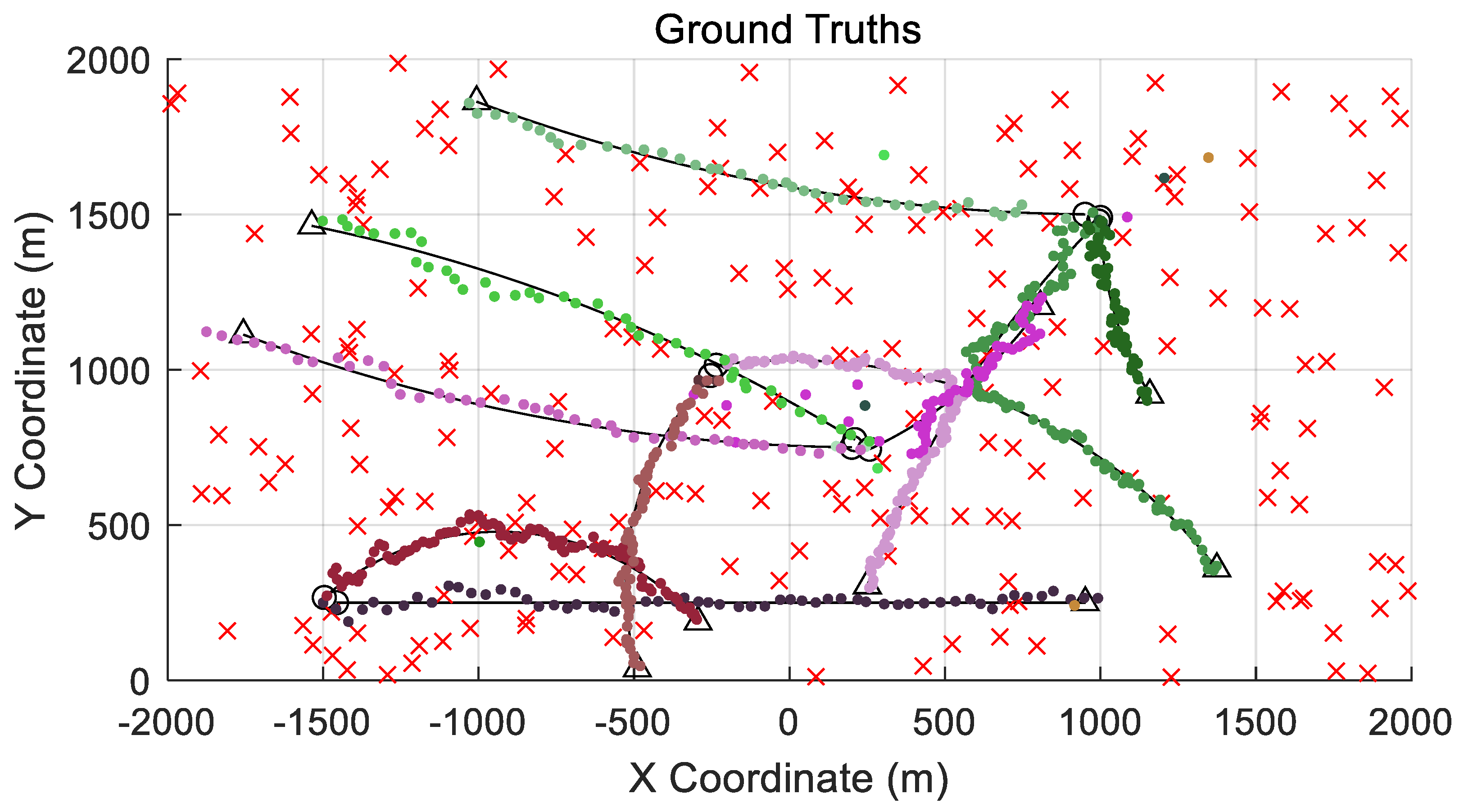

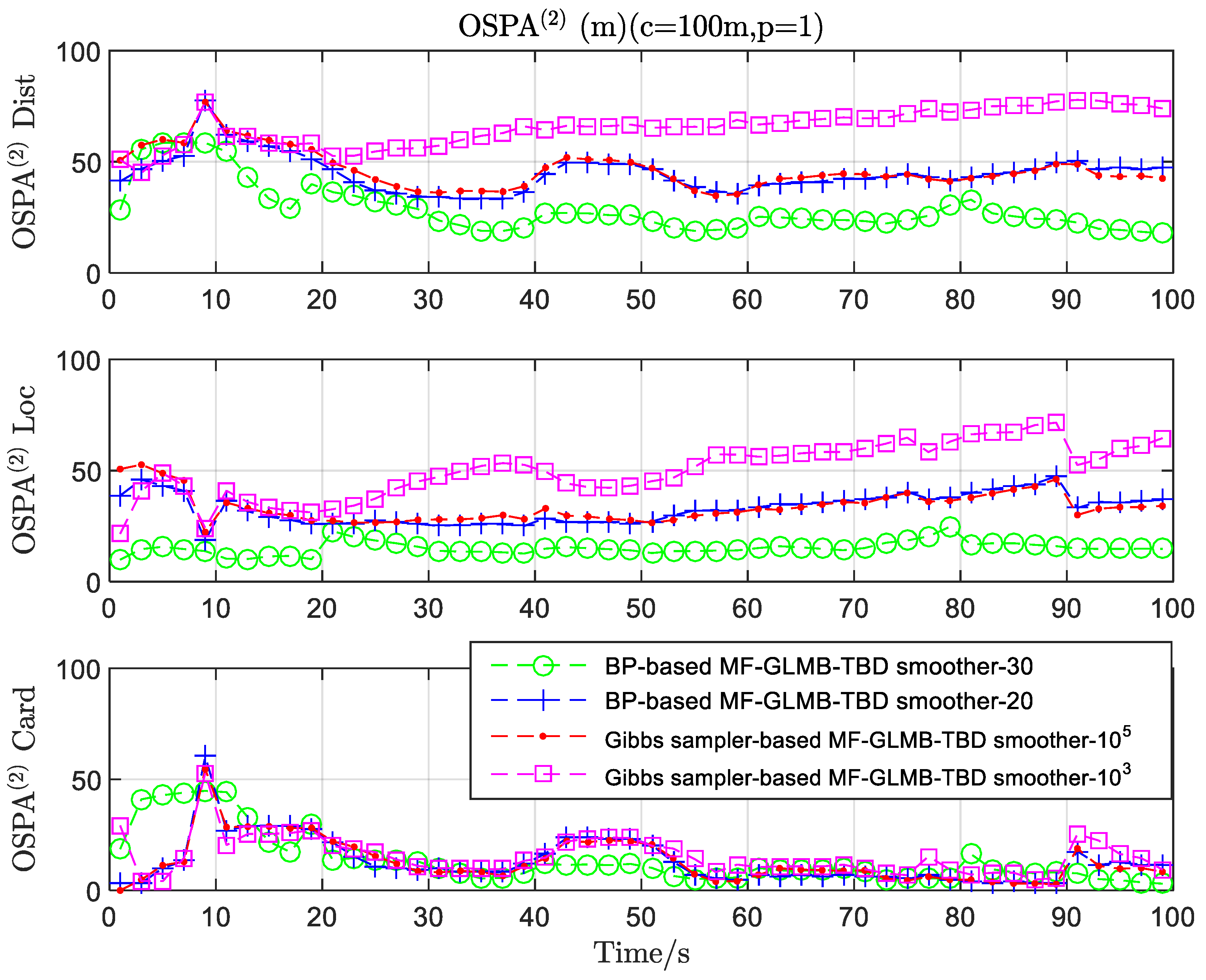
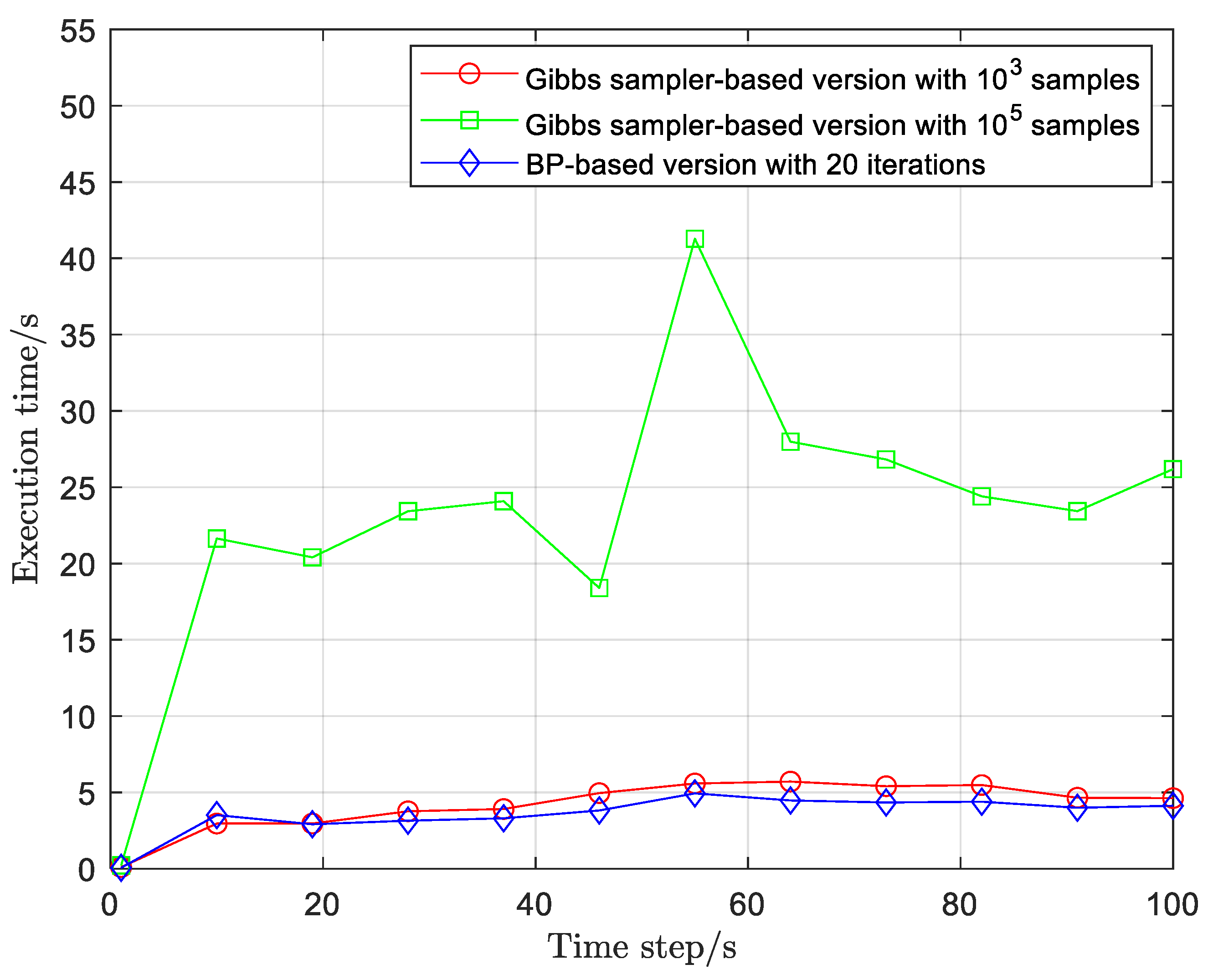
| Parameter | Symbol | Value |
|---|---|---|
| Loss coefficient | ||
| Sampling time | ||
| Survival probability | ||
| Signa-to-noise ratio | SNR | 7 dB |
| 1st Birth target state | ||
| 2nd Birth target state | ||
| 3rd Birth target state | ||
| 4th Birth target state | ||
| Birth covariance |
Publisher’s Note: MDPI stays neutral with regard to jurisdictional claims in published maps and institutional affiliations. |
© 2022 by the authors. Licensee MDPI, Basel, Switzerland. This article is an open access article distributed under the terms and conditions of the Creative Commons Attribution (CC BY) license (https://creativecommons.org/licenses/by/4.0/).
Share and Cite
Cao, C.; Zhao, Y. A Multi-Frame GLMB Smoothing Based on the Image-Observation Sensor for Tracking Multiple Weak Targets Using Belief Propagation. Remote Sens. 2022, 14, 5666. https://doi.org/10.3390/rs14225666
Cao C, Zhao Y. A Multi-Frame GLMB Smoothing Based on the Image-Observation Sensor for Tracking Multiple Weak Targets Using Belief Propagation. Remote Sensing. 2022; 14(22):5666. https://doi.org/10.3390/rs14225666
Chicago/Turabian StyleCao, Chenghu, and Yongbo Zhao. 2022. "A Multi-Frame GLMB Smoothing Based on the Image-Observation Sensor for Tracking Multiple Weak Targets Using Belief Propagation" Remote Sensing 14, no. 22: 5666. https://doi.org/10.3390/rs14225666
APA StyleCao, C., & Zhao, Y. (2022). A Multi-Frame GLMB Smoothing Based on the Image-Observation Sensor for Tracking Multiple Weak Targets Using Belief Propagation. Remote Sensing, 14(22), 5666. https://doi.org/10.3390/rs14225666






